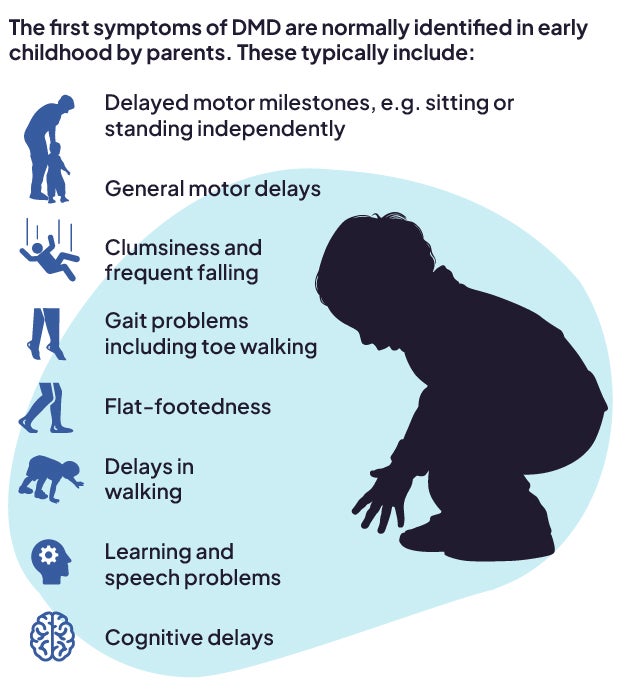Duchenne Muscular Dystrophy (DMD): Overview, Symptoms, Diagnosis, and Treatment

What is Duchenne Muscular Dystrophy?
Duchenne muscular dystrophy (DMD) is a severe, progressive genetic disorder characterized by muscle degeneration and weakness. It primarily affects boys and is caused by mutations in the DMD gene on the X chromosome, leading to an absence or deficiency of dystrophin—a protein essential for maintaining muscle fiber integrity. Without dystrophin, muscle cells become fragile and break down over time.
DMD is the most common form of muscular dystrophy, occurring in approximately 1 in 3,500 to 6,000 male births worldwide. It follows an X-linked recessive inheritance pattern, meaning mothers who carry the mutation can pass it to their sons.
Signs and Symptoms
- Onset: Symptoms typically appear between ages 2 and 5 but may be noticeable as early as infancy.
- Muscle Weakness:
- Begins in proximal muscles (hips, pelvic area, thighs) and progresses to shoulders, arms, respiratory muscles, and heart.
- Early signs include frequent falls, difficulty running, jumping, climbing stairs, and rising from the floor (Gowers’ sign).
- Waddling gait and toe walking are common.
- Calf muscles often appear enlarged due to fat and connective tissue replacement (pseudohypertrophy).
- Motor Delays: Delayed walking and difficulty with motor skills.
- Progression: Most boys lose the ability to walk by age 12.
- Cardiac and Respiratory Involvement: Cardiomyopathy and respiratory muscle weakness develop with disease progression, often leading to heart failure and respiratory complications in late teens or early adulthood.
- Other Features: Learning disabilities or mild intellectual impairment may occur but do not worsen over time. Scoliosis is common as muscle weakness progresses.
Diagnosis
- Clinical Evaluation: Physical exam noting muscle weakness pattern and family history.
- Blood Tests: Elevated creatine kinase (CK) levels indicate muscle damage. Genetic testing identifies mutations in the DMD gene in about two-thirds of cases.
- Muscle Biopsy: Examines muscle tissue for dystrophin absence or abnormalities when genetic tests are inconclusive.
- Electromyography (EMG): Differentiates muscle disease from nerve disorders.
- Imaging and Cardiac Tests: MRI or CT may assess muscle and heart involvement; ECG evaluates cardiac rhythm.
Current Treatment
- Glucocorticoids: Corticosteroids (e.g., prednisone, deflazacort) slow muscle degeneration and improve strength and function.
- Physical Therapy: Maintains mobility and reduces contractures.
- Cardiac Management: Medications and monitoring for cardiomyopathy.
- Respiratory Support: Non-invasive ventilation and therapies to manage respiratory insufficiency.
- Orthopedic Interventions: Bracing and surgery for scoliosis or contractures.
- Nutritional Support: To maintain overall health.
- Emerging Therapies:
- Gene Therapy: Using viral vectors to deliver functional dystrophin genes.
- Exon Skipping Agents: Drugs like eteplirsen that allow cells to skip faulty exons and produce a shorter but functional dystrophin protein.
- These therapies aim to slow disease progression and improve quality of life.
Prognosis
Without treatment, DMD leads to loss of ambulation by early adolescence and life-threatening cardiac and respiratory complications by early adulthood. Advances in multidisciplinary care and emerging therapies have extended life expectancy into the 30s and beyond for some patients.
Summary
| Aspect | Details |
|---|---|
| Cause | Mutation in DMD gene causing dystrophin deficiency |
| Inheritance | X-linked recessive (mostly affects boys) |
| Onset | Early childhood (2–5 years) |
| Key Symptoms | Progressive muscle weakness, frequent falls, waddling gait, enlarged calves, scoliosis |
| Diagnosis | Clinical exam, elevated CK, genetic testing, muscle biopsy |
| Treatment | Corticosteroids, physical therapy, cardiac and respiratory care, gene/exon skipping therapies |
| Prognosis | Progressive; loss of walking by ~12 years; life expectancy into 20s–30s with care |
Consult with Our Team of Experts Now!
At DrStemCellsThailand (DRSCT)‘s Anti-Aging and Regenerative Medicine Center of Thailand, we emphasize comprehensive evaluations and personalized treatment plans of Cellular Therapy and Stem Cells for managing various health conditions. If you have questions about Duchenne muscular dystrophy (DMD) or would like more information on our services, consult with our experts today!
Consult with Our Team of Experts Now!
References
- Title: Duchenne Muscular Dystrophy: From Diagnosis to Therapy
DOI: 10.1016/j.neulet.2023.137034
Summary: This review provides a comprehensive overview of Duchenne muscular dystrophy (DMD), including its genetic basis, clinical features, diagnostic strategies (such as genetic testing and muscle biopsy), and current as well as emerging therapeutic approaches (including corticosteroids, exon skipping, and gene therapy). The article also discusses prognosis and advances in multidisciplinary care that have improved life expectancy and quality of life for DMD patients.
Duchenne muscular dystrophy is a serious genetic disorder causing progressive muscle weakness due to dystrophin deficiency. Early diagnosis and comprehensive care are essential to improve quality of life and extend survival. Emerging gene-based therapies offer hope for altering the disease course in the future.















